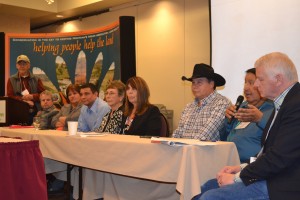
Panelists discuss ways that USDA agencies, Bureau of Indian Affairs (BIA) and Tribal Nations can better serve Indian agricultural producers and tribal communities on day two of the three-day USDA Tribal Outreach Forum held March 23-25 in Bozeman, Montana. More than 100 tribal, federal, state officials, agricultural producers and extension agents attended the statewide USDA event, including representatives from the seven Indian reservations in Montana.
The U.S. Department of Agriculture (USDA) held a USDA Tribal Outreach Forum in Bozeman, Montana, to discuss federal and state agricultural programs and initiatives, activities and opportunities with tribal leaders and other representatives in Indian Country.
The USDA Tribal Outreach Forum gives USDA, Tribal Nations and agricultural partners like Intertribal Agriculture Council (IAC) and Indian Nations Conservation Alliance the chance to open a dialogue and develop relations that benefit the agricultural tribal community.
“Tribal outreach and program education is an important priority for USDA and Tribal leadership” said Bruce Nelson, USDA Farm Service Agency (FSA) state executive director in Montana. “We look forward to our continued work together to help grow and strengthen conservation efforts, agricultural operations, businesses and tribal communities.”
Agriculture is a major employer to the Indian tribes who inhabit approximately 8.5 million acres of reservation land in Montana, or 9 percent of the state’s total land base and where beef cattle outnumber people 2.5 to 1. Consequently, connecting American Indians to USDA outreach and educational events, such as the USDA Tribal Outreach Forum, is a priority.
Each year, USDA leaders in Montana travel to each reservation to meet with tribal leaders and their staff in their respective headquarters to assess the agricultural projects they work on together throughout the year. These projects involve natural resources, rural development, agriculture, food and nutrition.
USDA, Tribal Nations, Bureau of Indian Affairs, IAC, INCA, Tribal Colleges and other important agricultural partners will continue to work together to tackle ongoing barriers and future challenges, such as American Indian youth living on reservations not being able to have as much access to the 4-H program, or clarifying and streamlining USDA programs, regulations, Indian land and federal Trusts.
To learn more about the USDA’s work with Indian tribes, click here. And to learn more about Montana’s work with farmers and ranchers, visit the Farm Service Agency website in Montana at www.fsa.usda.gov/mt.





